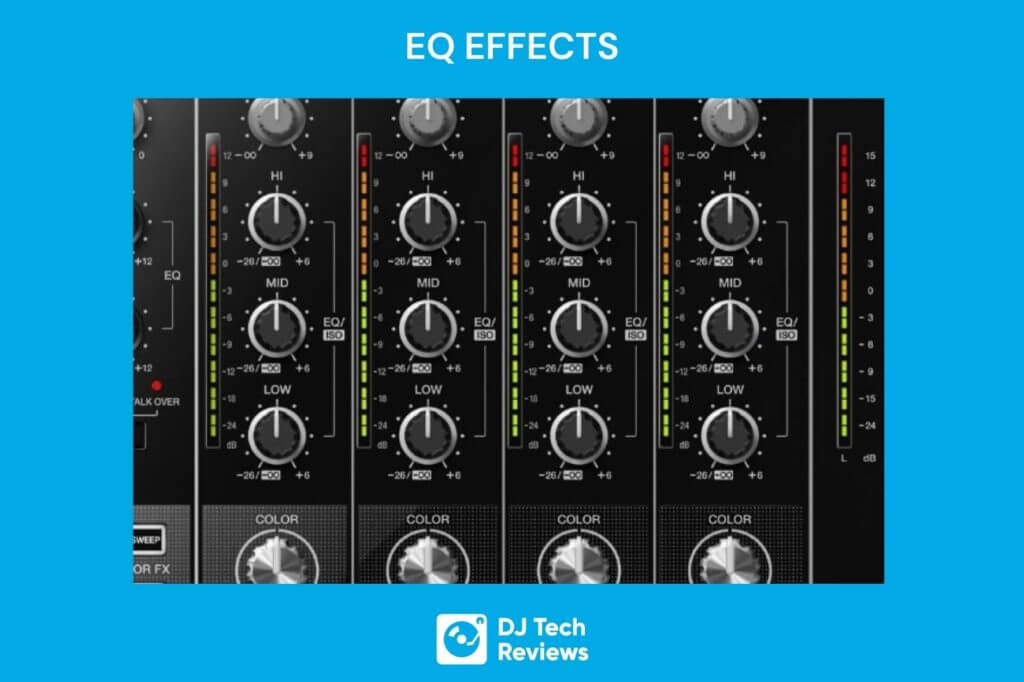There are many vital skills a DJ must have to properly perform on stage.
Arguably one of the most important of those skills, however, is using Eqs on a DJ mixer properly and accurately.
Beatmatching, crossfading, or channel fading, while all important in their own right, can still result in a horrible sounding experience without the DJ having an adequate amount of training with EQ effects. By having a solid foundation and a strong understanding of EQ utilization, any DJ can immediately begin to take their skills to the next level.
The good news is that, with rare exceptions, even the cheapest and least expensive DJ controllers have some method of adjusting their respective EQ levels.
If a controller has no way to alter the EQ levels, you probably don’t want to mess with it.
Throughout this guide, we’ll be going over and covering all the different factors worth considering when it comes to playing with a controller’s EQ levels.
We’ll also go over how to more effectively bring those aspects into your own DJ experience.
Using EQs on a Mixer (in short)
the average DJ controller, DJ mixer, or, DJ software will generally always feature a 3 band equalizer (EQ). These EQ frequencies include the low-end, mid-range, and high-end frequencies. Whilst a DJ mixes tracks together, the EQs are diligently adjusted to control and blend together the different elements of both tracks.

RELATED ARTICLES: Using DJ Sound Effects Properly (The Top 5 FX)
Knowing How Sound Works
Before we can get into EQ levels and how to play with them as a DJ, it’s important to first understand the basic principles surrounding sound and how it works.
Now, while sound is a fairly complex topic with a lot of different facets, you don’t need to be an expert in the field to know anything about EQing.
Rather, so long as you have even a general basic understanding of the subject and how it works when dealing with music, you should be alright.
Essentially, when it comes to sound, all you have to know is that sound is produced via specific waves. You also need to know that these waves continually vibrate through the air in a specific pattern before being picked up by our ears.
These sound vibration waves move at different frequencies based on their nature; some being at lower frequencies while others coming at much higher frequencies.
A clear and simple example showing this can be seen with bass drums compared with vocals.
While a bass sound is almost always going to register at a lower sound frequency, vocals will either register at middle or higher-end frequencies, based on the nature of the voice. Similarly, while melodies and percussion elements generally sit at the middle-end frequencies, stringed instruments are often going to register along the higher end.
Higher-End vs. Lower-End Frequencies
Because our ears naturally prioritize higher-end frequencies, often perceiving them as being “louder”, we also tend to regard lower-end frequencies as generally being “softer”.
As a result, this is often why most recorded music tends to have a special emphasis placed on lower frequencies; effectively attempting to strike a balance with higher-end frequencies in terms of overall loudness.
What Happens When Two Frequencies Play Simultaneously?
When two sound frequencies are being played at the same time along a single channel, it can often result in the overall “loudness” of a song going up.
This is true regardless of the frequency nature.
Whether it’s two of the same or different frequencies, because they are being played at the same time, the sound and loudness will naturally go up.
An easy example of this is when two drums are being played simultaneously. Even if both are being played at a specific sound level, the loudness will naturally increase, even potentially resulting in a sound distortion (or “audio clipping”).
This is why EQ leveling is so important.
Using EQs on a DJ Mixer. What Actually is This?
As it pertains to a DJ’s equipment, the low, mid, and high-end frequencies are all able to be freely tweaked and manipulated directly.
This is what’s known as “EQ leveling”. As virtually all DJ controllers and speakers will have a way to alter the different sound frequencies, a DJ must know how to best alter them so that the best sound quality comes out.
EQ Knob Layout
For most DJ equipment, the EQ leveling options will be handled by way of specifically listed knobs.
These are generally right above the channel faders and filters, though not every controller layout is the same.
Both, each respective controller channel as well as each respective sound frequency will have their knob to play with and alter.
As an example, while a 2-channel controller will have two sets of three EQ knobs, totaling six individual knobs, a 4-channel mixer will have four sets of three EQ knobs, totaling 12 knobs.
The general default position for a DJ controller’s EQ knobs will be at the 12 o’clock position. Turning the knob clockwise will generally increase a frequency’s volume while turning it counter-clockwise will reduce its volume.
As a DJ, you’ll need to know when to adjust these knobs to better emphasize certain parts of a track’s sound. They can also be used to introduce a new track or to adjust the frequency of the existing track to better make room for any additional new elements.
The Ideal Sound Frequency Level
While there are certainly different nuances to consider (many of which we will go over later), the general rule when it comes to sound volume level is that it should always be at 100%.
As an example, if the mid-EQ for channel 1 is set at 70% volume, you should have channel 2’s mid-EQ level set at 30%.
This means that going above 100% (110%, 150%, 200%, etc) can lead to many of the clashing and excessively loud scenarios as we touched on earlier.
A good idea is to, when using your equipment, play a simple song and adjust the knobs to better familiarize yourself with its effects.
You’ll notice that some songs will have bass lines that spill from the lower-ends out into the mid-range frequencies, or vocals that rapidly range and fluctuate between mid and high-end frequencies.
Understanding the balance between these constantly moving and changing frequencies, and knowing when to raise one and lower another, is the hallmark of a skilled and accomplished DJ.

Mixing With Different EQ Frequencies
Now that we’ve gone over the various basics surrounding EQs, EQ knobs, and how different sound frequencies work, we can now jump into the best ways to use the respective audio frequencies when mixing and performing.
Using Low-End Frequency EQs
The low-end frequency EQs generally deal with drums and bassline sounds over everything else. As mentioned earlier, because low-end frequencies come across as “softer” than mid and high-range frequencies, they will often take up a much larger space of focus, comparatively speaking.
Because of this, low-end frequencies are the most sensitive areas for an EQ, requiring only minor tweaks and adjustments from their neutral position.
Pushing more than that can often result in audio clipping and sound distortions.
Bass Swapping
A fairly common method used by DJs is a technique known as “bass swapping”. While fairly simple, bass swapping is incredibly effective. The DJ will turn channel 1’s bass down as low as possible while simultaneously turning channel 2’s bass up as much as possible.
This technique has a lot of use and is best used in line with a specific core phrase from a track. For example, at the end of a 32-beat phrase, you immediately swap basslines between channels 1 and 2.
Pitfalls Of Bass Swapping
As you can see from the above example, timing is incredibly important when doing this type of mixing. You don’t want to drop the bassline in the middle of a beat phrase, nor do you want to wait too long after the phrase is over to try dropping it either.
Because we are conditioned to hear music in patterns, anything that causes a major or dramatic shift – outside of its natural phrase length – can immediately come across as jarring and overall unpleasant.

Another thing you’ll want to always be mindful of is the bassline type. For example, a booming bassline that is cut and replaced with a weaker-sounding bassline can be just as jarring and grating as swapping too early or too late.
The optimal setup is, instead, to have a more gradual transition out from channel 1 and its bassline before slowly progressing into channel 2’s less powerful bassline EQ.
This, rather than upsetting the sound’s flow, can improve and enhance it.
Channel Fading vs. EQ Mixing
The big difference between bass swapping and EQ mixing, when compared to channel fading with a channel fader, is the expected and understood energy loss.
Whereas bass swapping (provided the timing’s right) can keep the energy up as the songs transition from one to another, channel fading is an innately gradual process.
This means that, simply by fading out from channel 1’s bassline to channel 2, no matter how high the energy initially might be, will slowly begin conditioning the audience to accept and understand that the energy level is going to be at least somewhat different.
Using Mid-Range Frequency EQs
Mid-range frequency EQs often contain large portions of a song’s vocal and melodic aspects. This area is also known for hosting various percussion instrument elements.
Because this area has such a broad variety of sounds available within this specific range, it is generally ok to have both channels playing at nearly full level, something normally frowned upon. This scenario is especially the case as it pertains to electronic music.
While it isn’t recommended that you have both EQs at full power, because mid elements tend to be designed with space for new sound elements within their soundscape, they have much more “wiggle room” to play with compared to low or high-end sounds.
Pitfalls of Mid-EQ Mixing
Often mid-EQs have too many sound elements to come across as completely natural. More often than not, these frequencies will spill out from the bassline and into the mid-EQ. This can result in the mid-EQ needing to be turned down lest the bassline results in a wholly unnatural sounding mix.
You should also know that, while a large number of vocals do sit in the mid-EQ, some don’t. By cutting the mid-EQ, you aren’t removing any vocal elements in the song.
Rather, in reality, you’re just going to make a strange muffled sound, with only the high and low aspects of the vocals being registered.
Your best bet is to just stick with fine adjustments that focus on the mid-range area and more on compatible track selection or intro timing.

Using High-End Frequency EQs
High-end frequency EQs are largely dominated by snares, hi-hats, and higher frequency vocals and melodies.
As mentioned earlier, our ears are very sensitive to high-end frequencies, often perceiving them as being “louder” than either mid or low-end frequencies.
Because of this, you must be very careful when tweaking them. Unlike the other options, which may potentially be ignored depending on the situation, an instant kill or issue with high-end EQs will immediately be noticeable (think nails on a chalkboard or a high-pitched screech).
It’s often best to either gradually fade a song’s high frequency out, or correctly time it with the second channel’s high-end frequency.
This not only ensures there is no grating sound alteration but also naturally flows the transition while retaining the same energy levels.
High-End Dropping
Generally, dropping in on the higher end of an incoming track isn’t going to have too many problems or issues. This is usually because high-end sounds are filled with hi-hats, generally making any transition seem like an additional element of the current existing track.
This method of transitioning is also great in that it conditions the audience to listen for any new sounds. It also allows you to better transition songs without having to fade in or out as you would with mid and lower-range frequencies.

RELATED ARTICLE: The 2 Channel v 4 Channel Mixer Debate (Answered)
Pitfalls Of High-End Dropping
As with all other EQ mixing techniques, it’s all about where the energy currently is as well as where it’s potentially heading.
If you’re dealing with a new track but it doesn’t have that much going for it within the high-range frequencies, you’re going to immediately notice a clear difference the moment the first track ends and the second one begins.
Finding the ideal spot in a track – such as the start of a break or during the chorus – is ideal as it can briefly kill the high-end, creating a more natural feel for the listener.
Ultimately, by understanding the nature and structure of a song, you will be able to better know when a larger change in the high-end frequency is about to begin.
You’ll then be able to cut any previous high out at that precise moment before dropping the second channel’s sound in.
Using EQ Levels on a DJ Mixer: Summary
Now you know much more about the fundamentals of Using EQ levels on a DJ mixer.
Ultimately, it all comes down to the P-word, practice! You must train your ears.
EQ mixing is an ever-constant and always-shifting situation, that only the best DJs ever truly master (There’s a reason a DJ tweaking the EQs is a classic image). By managing to strike the balance between two songs and their ever-changing frequency levels, you can create and develop some truly impressive sound mixes.




